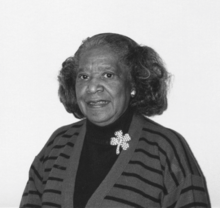Mary Jackson (engineer)
| Mary Jackson | |
|---|---|
 | |
| Born |
Mary Winston April 9, 1921 Hampton, Virginia |
| Died |
February 11, 2005 (aged 83) Hampton, Virginia |
| Nationality | American |
| Institutions | NASA |
| Alma mater | Hampton University |
Mary Winston Jackson (April 9, 1921 – February 11, 2005) was an American mathematician and aerospace engineer at the National Advisory Committee for Aeronautics (NACA), which later became the National Aeronautics and Space Administration (NASA).
Personal life
Mary Jackson was born on April 9, 1921, the daughter of Ella (née Scott) and Frank Winston. She grew up in Hampton, Virginia, and attended high school there, where she excelled. She earned her Bachelor's degrees in mathematics and physical science from Hampton Institute in 1942.[1][2] Jackson spent twenty years as a Girl Scout leader.[3] She was noted for helping Black children in her community to create a miniature wind tunnel.[2][4]
Jackson was married with two children.[2] She died on February 11, 2005.[1]
Career
After graduating from the Hampton Institute, Jackson taught school in Maryland. In 1943, she became a secretary and bookkeeper for the USO.[5] She joined the National Advisory Committee for Aeronautics (NACA), which later became the National Aeronautics and Space Administration (NASA), in 1951.[2][6][4] She began her career there as a research mathematician, or computer, at the Langley Research Center in her hometown of Hampton, Virginia. In 1953 she moved to the Compressibility Research Division.[7] After five years at NASA and after taking several additional courses, she joined a special training program and was promoted to aerospace engineer.[4] She then worked to analyze data from wind tunnel experiments and real-world aircraft flight experiments at the Theoretical Aerodynamics Branch of the Subsonic-Transonic Aerodynamics Division at Langley.[2][3] Her goal was to understand air flow, including thrust and drag forces.[2] Many years later, she was assigned to work with the flight engineers at NASA.[8]
Jackson worked to help women and other minorities to advance their careers, including advising them how to study so that they could change their titles from "mathematician" to "engineer" to increase their chances of promotion, which she did herself.[8]
After 34 years at NASA, Jackson reached the highest level of engineer that was possible for her without becoming a supervisor. She decided to take a pay cut and change positions to become an administrator in the Equal Opportunity Specialist field. After undergoing training at NASA Headquarters, she returned to Langley where she worked to make changes and highlight women and other minorities who were accomplished in the field. She served as both the Federal Women’s Program Manager in the Office of Equal Opportunity Programs, and as the Affirmative Action Program Manager.[8] She worked at NASA until her retirement in 1985.[1]
Legacy
Jackson is featured in the 2016 film Hidden Figures about three African-American women at NASA that calculated flight trajectories for Project Mercury and Apollo 11 in the 1960's. It is based on the book by the same name by author Margot Lee Shetterly that documented the NASA careers and contributions of Katherine Johnson, Dorothy Vaughan and Jackson. Jackson will be portrayed by Janelle Monáe.[9]
References
- 1 2 3 "Mary Winston Jackson". Daily Press. 13 February 2015. Retrieved 16 August 2016.
- 1 2 3 4 5 6 Warren, Wini (1999). Black Women Scientists in the United States. Bloomington, Indiana, USA: Indiana University Press. p. 126. ISBN 9780253336033.
- 1 2 "Mary Jackson". Introductions Necessary. 27 April 2016. Retrieved 16 August 2016.
- 1 2 3 Lewis, Shawn D. (August 1977). "The Professional Woman: Her Fields Have Widened". Ebony. Johnson Publishing Company. 32 (10). ISSN 0012-9011.
- ↑ Shetterly, Margot Lee (2016-09-06). Hidden Figures: The American Dream and the Untold Story of the Black Women Mathematicians Who Helped Win the Space Race. William Morrow. p. 95. ISBN 9780062363596.
- ↑ "Mary Winston Jackson". Human Computers at NASA. Macalester College. Retrieved 16 August 2016.
- ↑ Mary W. Jackson (pdf), National Aeronautics and Space Administration, October 1979, retrieved 16 August 2016
- 1 2 3 Champine, Gloria R. "Mary Jackson" (PDF). NASA. Retrieved 16 August 2016.
- ↑ Buckley, Cara (20 May 2016). "Uncovering a Tale of Rocket Science, Race and the '60s". The New York Times. ISSN 0362-4331. Retrieved 16 August 2016.